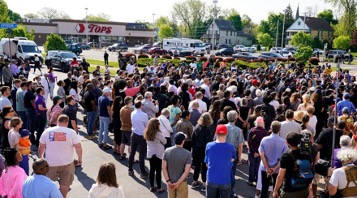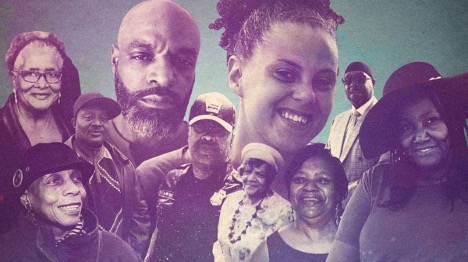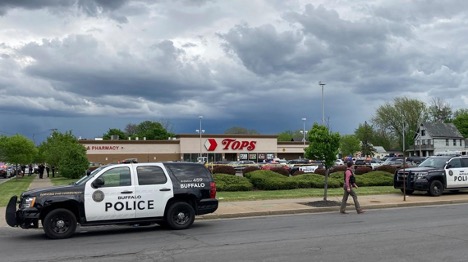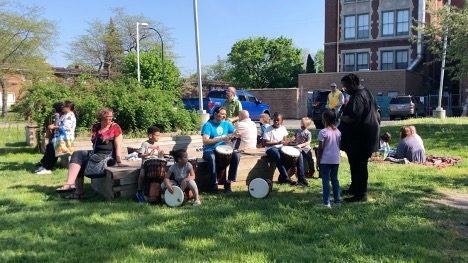By: Sarah A. Robert and Kate Haq
For this Audio/Visual Essay, we reflect through four images on the crisis of white supremacy in the aftermath of a(nother) white supremacist attack on our community, the May 14, 2022, Tops Supermarket Massacre in Buffalo, NY. The city is both our home and the field (Bourdieu 2005; Thompson 2014) of our publicly engaged research. Emblematic of the institutionalization of white supremacy (1619 Project, 2019), Buffalo is built on the lands of the Seneca [Onödowa’ga:’] by white settlers. It was the last station on the Underground Railroad before reaching freedom in Canada; it was not the promised land for enslaved Blacks. An iconic rustbelt city, the disciminatory job market and wealth of (de-)industrialization reflect the intersectionally classed, gendered, and raced dynamics of capitalism. Buffalo is the third poorest and one of the most racially/ethnically segregated United States’ cities (Blatto 2018). It has lost federal and state legal actions because the school district violates the civil rights of its Black and Brown students (Haq and Schindel 2018; Orfield and Ayscue 2018). The Oxford Advanced American Dictionary defines crisis as “a time of great danger, difficulty, or confusion when problems must be solved or important decisions must be made.” Our community continues to differentially experience great danger and difficulty. This essay calls out the hidden crisis of whiteness in our community rather than centering on the anti-Black racism that is fueled by it. In so doing, we offer reflections for moving through politicized white identities toward an emancipatory framework for a community in crisis.
"The crisis of white supremacy before, during, and after the Tops Massacre includes acts of violence and dehumanization as well as inertia and fleeting empathy. White Buffalonians’ inaction must be understood as an action, a privilege that propels the negative impacts of whiteness in our city."
The crisis of white supremacy before, during, and after the Tops Massacre includes acts of violence and dehumanization as well as inertia and fleeting empathy. White Buffalonians’ inaction must be understood as an action, a privilege that propels the negative impacts of whiteness in our city. Fleeting empathy is replaced by silences among whites as well as conversations in which whites deny or shut down opportunities to discuss white supremacist acts, the emotions, and the material impacts that they engender, as well as their historical foundations. The result is sustained symbolic and everyday violence inflicted on and endured by nonwhites.
The four images below are scenes from the days after the mass murder of our neighbors. Celestine Chaney, Roberta Drury, Andre Mackneil, Katherine “Kat” Massey, Margus Morrison, Heywood Patterson, Aaron Salter, Geraldine Talley, Ruth Whitfield, and Pearl Young were gunned down in their neighborhood supermarket on the Eastside of the city. They are Black, and the neighborhood is a Black neighborhood. These two facts must be made visible against the white-hot ideologies of this specific violent incident of racial superiority, of othering and dehumanizing, and their foundations. How might our white neighbors learn about and from this specific act of white supremacy in order to work constructively to heal the ongoing wounds of white-inflicted violence and toward recognizing and dismantling the institutions that sustain such violence? Our search for answers to this question is part of our evolving awareness of whiteness as ideological, embodied, and systemic. Professor Janet E. Helms’ Stages of White Awareness is but one potential approach for processing white supremacy that is the cause of harm to our Black and Brown neighbors. This is important whiteness work, not to whitewash the crisis in our midst, but situate it as the problem inflicting harm.
Our collaboration is an attempt to work on the immersion stage of white awareness when “concern deepens enough to start conversations with other Whites about racism who are or have been dealing with issues of racism” (Retrieved from https://www.whiteawareness.com/). We read the Home/Field call as a challenge to learn about (our) whiteness and white supremacy in our community and to take responsibility for it. However, one of the first challenges was selecting images. How do we select and review images, publicly, such that it is more than a theoretical exercise? How do we select images that honor the trauma of the Massacre but do not feed into crisis ‘porn’ or sensationalize white supremacist violence? “Trauma does not go away once the news moves on” (Otaño Gracia 2020). We understand and acknowledge/warn that the images differently induce trauma along a full spectrum of human emotions. Our selection makes visible the crisis that white Buffalonians must immerse themselves in, discuss, and ameliorate.
We strive for the autonomy stage, “the last stage of positive white identity reached when an individual has a clear understanding of and positive connection to their white racial identity while also actively pursuing social justice … [and seeking] balance, even as they stay open and recognize there is always more to learn.” Crises happen in our city. Regardless of whether this was in the adjacent “backyard,” white supremacy is the crisis that white neighbors must process and confront as whites. That starts by speaking together and learning about our whiteness in ways that honor the potential for a positive racial identity that denounces and strives against harm and fear of our Black and Brown neighbors.
EXAMPLE 1: Say their names / Murdered Neighbors
“You don’t know a damn thing about Black people. We are human!” Barbara Massey, Kat Massey’s sister, stated to her sister’s murderer during the sentencing hearing at the Erie County Courthouse. We must say their names: learn of them, learn from them, their work, and their example, and their presence in our city during their truncated lives. Read media accounts of their lives. See them: the women, the men, the young, the elders. Know that they are gone and left behind deep and broad and intimate relationships with severed braids, kinship networks with gaps, projects and dreams not deferred but left undone. Learn from their families and loved ones who are processing grief and seeking justice. Despite so many divides, we are aware of and at times prepared for the loss of community members, this is not–and should not be–a loss we prepare for or that we ignore, naturalize, and internalize as the norm. Yet such violence demands just that of us all. The ideologies of white supremacy that influenced the murderer demand that white neighbors don’t [get to] know non-white people, don’t live near them, and don’t acknowledge the humanity of the victims. We should reject this as part of an “…insidious caste [system] … the worn grooves of comforting routines and unthinking expectations, patterns of a social order that have been in place for so long that it looks like the natural order of things” (Wilkerson 2023). The murder of Black Buffalonians is not natural, it is inhumane. We must strive for humanity, to live humanely, and to act for human rights and dignity for all and together.
EXAMPLE 2: The looming clouds over a police presence
The heavy gray cloud cover looms over this scene of white supremacist violence. It is the weather as usual. It is white oppression as usual. It is the usual for a zip code already overpoliced, a zip code that was easily plucked from the internet as “the most Black.” Easily accessible by car if you have one and have the resources to drive three hours to scout it and return to it. White supremacist violence is as mundane as it is not. The ways the immediate crisis was de-escalated by the police speak to ongoing disproportionate treatment of our Black and Brown neighbors by the State. The officers captured the white murderer alive without firing a bullet, taser, or using a chokehold or other physical violence. The murderer was safely taken away, physically unharmed, never to return to the neighborhood. However, survivors and their loved ones remain in this place of sorrow. We can drive by, curious to see what the scene looks like, but do you see the foundations of white supremacy beyond the memorials? Our neighbors shopped in this majority Black neighborhood’s only grocery store and that was no accident but rather another example of the racist policies and laws that create boundaries to uphold US institutions and white intergenerational wealth (1619 Project; Rothstein 2018). Meanwhile in dominant white neighborhoods life carried on. Our grocery stores (plural) were still open. To the right of the image, note the empty lots, the absence of homes, the roof in need of repair. With an aging housing stock, redlining within a discriminatory housing market, historic white flight, and purposeful environmental degradation (Miles, Haq and Shippens 2021), the go-to government response has been to demolish and wait for investors from outside to begin the gentrification process or neighborhood revitalization. These are the visuals of white supremacist policies.
EXAMPLE 3: Community?
People gathered in the aftermath of the Massacre. This image reminds us of the artist Alfredo Jaar’s conceptual work titled, Life Magazine, April 19, 1968 (1995) and begs us to ask the question: But did we? Jaar places three versions of the iconic image of Martin Luther King, Jr.’s funeral procession next to each other: the original, one with all the Black attendees denoted with dots on their faces, and one with all the white attendees’ faces identified. It shows us so simply who shows up in a moment of racial reckoning. If we do what Jaar does in his work, do we see white people? Buffalonians showed up to support victims, to grieve, and to heal. In the aftermath, generational wealth and advantage were redistributed. Whites showed up, able to share advantages of privilege: time, safe and stable food sources, reliable transportation, good health, tangible materials, and money. Business owners provided money because they could and because of beneficial tax structures. Over the summer of 2022, the City of Good Neighbors showed up and eventually left. Months passed and the only grocery store in the neighborhood remained closed, a crime scene and a scene of horrific trauma. Still more months passed, and the city was hit by two blizzards that trapped our poorest neighbors in their homes without food, water, or heat. Our Black neighbors, who are disproportionately the city’s poorest residents, suffered new crises and trauma in ways that the vast majority of our white neighbors could overlook. Ongoing grief and heartache reverberated through the spring across the Black community, evident throughout court appearances and sentencing while for most white Buffalonians proceedings were noted in passing if at all and/or observed from afar.
The crisis of white supremacy continues. What are whites showing up for a year since the Massacre? Where can we show up and stand up for justice? The Western New York Peace Center is a long-standing organization to learn from and where you might get involved. Try Showing Up for Racial Justice (SURJ) to learn about white privilege and to work through the stages of white awareness. Ready to act? Why not look to Our City Action Buffalo to learn about local politics while trying to change them? In addition to becoming more active within social and racial justice spaces, consider supporting some of the Black-led organizations that are in the community working to improve environmental, social, and economic outcomes for Eastside residents. Nonprofits such as Every Bottom Covered, Inc, Our Mommie Village, Inc, The Galactic Tribe, Inc, Feed Buffalo, Inc, Project Mona’s House, Inc, and Confident Girl Mentoring Program, Inc. understand the needs of the community because they live, work, and play there. As small, mission-driven nonprofits, they struggle to keep the lights on even as they are addressing the needs of the community.
EXAMPLE 4: Going to Public School on May 19, 2022
Barbara Massey, Kat Massey’s sister, teaches us of and through her grief: “We are still living but our hearts don’t beat the same.” Drum circle is a regular part of many of the city’s public school events. This event, which took place days after the Massacre, was the first school-wide event since January 2020. Schools, like many institutions, were closed in March 2020 by Covid-19. They remained closed to in-person instruction for a year, followed by another year during which the city’s schools were closed to all but staff and students as the virus disproportionately ravaged Black and Brown communities. The event was to be a celebration of Spring and shared with multi-generational, multi-racialized, multi-classed communities who also share the responsibility of educating our city’s children, together. Yet this event was almost canceled. Threats were made to this specific school because of its location in a majority Black neighborhood and its majority Black student population. The school is for children from 3 years old to 13 years old. What kind of person or people threaten children? White supremacists. The school’s leaders–administrators, parents, teaching assistants, and teachers–decided the event would be held anyway.
Note the yellow-vested community member who showed up to celebrate peace, to promote nonviolence, to demonstrate what civic engagement looks like. These vested individuals are part of Back-to-Basics Ministry, the Buffalo Peacemakers, a coalition of caring community members who work to build relationships, gather information, and mediate conflicts to prevent violence and redirect youth into healthy lifestyles. They broadened their mission this day to include mediating white supremacist threats and to celebrate our city’s children’s right to thrive. This image “turns our attention to those who are already operating under different modes of anthropological work that contribute to a living future in which work that illuminates and dismantles the logic of white supremacy will no longer be necessary, [and from which] we may draw hope” (Welcome 2020).
Questions of solidarity and community building include: Are you sending your children to public schools? Are you engaging with public schools and the segregation within them? As white educators at all levels, are you taking on the very difficult work of meeting with other white teachers to think and to learn and to act as allies for all students of color? Are you living in the community as civically engaged neighbors? Are you involved in your union and/or its transformation toward a community-engaged social justice organization? Are you facilitating civic experiences with and for your students? Are you involved in any civic experiences?
“How [can we] enact material changes within scholarship, teaching, and administrative practices that will actually contribute to . . . ” (Welcome 2020) emancipation? As the one-year anniversary of the Massacre passes, we look at and listen for the ways people have not begun, nor continued, to process crisis points. We want our white neighbors in Buffalo to become good neighbors, to join us on our journey across the stages of whiteness awareness. In a so-called “blue-collar city” we stress that it is our job to address white supremacy–with neighbors and family–and it starts by naming the crisis beyond one event that we continue to benefit from.
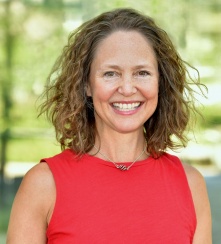
Dr. Sarah A. Robert
Dr. Sarah A. Robert is an international education policy expert.
Bio
She critiques how policy and politics shape and are shaped by the intersectional qualities of gender in global, South American, and US urban contexts. Her ethnographies and qualitative, social science-informed studies are concentrated on three areas: teachers’ work, school food, and curriculum/textbooks. As a first-gen, feminist, interdisciplinary public intellectual, she strives to demystify policy, to cultivate and support policy protagonists through teaching and long-term community collaborations, and to transform educational decision making into an inclusive process focused on realizing human rights and just transitions in educational institutions and for societies.
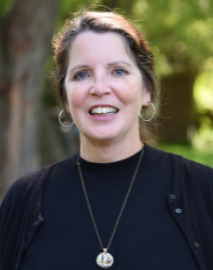
Dr. Kate Haq
Dr. Kate Haq is co-founder and VP of Operations and Curriculum Development at Mother Earth Literacies, LLC, a certified MWBE.
Bio
She has been a professional educator since 1985. Kate taught in urban and rural schools in Western New York, primarily as an elementary classroom teacher and literacy coach. Recently retired, Kate works to promote progressive, equitable, culturally responsive teaching and learning in Buffalo Public Schools as the curriculum chair for the Buffalo Parent Teacher Organization (BPTO) and in her role with Mother Earth Literacies supporting mission-driven Black-led organizations on the Eastside of Buffalo, NY. Kate is passionate about interdisciplinary equity-focused, place-based curriculum for K-12 educators and learners, interrogating the status quo, and the city of Buffalo. Kate’s research interests include teacher work and policy, youth civic engagement, environmental justice education, and critical literacies.
Works Cited
Blatto, A. (2018). A city divided: A brief history of segregation in Buffalo. Buffalo, New York: Partnership for the Public Good.
Bourdieu, P. (2005). The Social Structures of the Economy. Cambridge: Polity.
Hannah-Jones, N., Roper, C., Silverman, I., & Silverstein, J. (2019, August 18). The 1619 Project: A new origin story, First edition. The New York Times.
Haq, K., Schindel, A., (2018). Pushing Past Hate, Pushing Past Paladino: How one community organized for racial justice and to remove a school board member. Rethinking Schools,32 (4), 52-55.
Miles, M. L., Haq, K. & Shippens, E. (2021). “Hey, I live there!”: Unpacking environmental justice education and Whiteness in a rust belt city. In C. Hayes, I.
Carter & K. Elderson (Eds.) Unhooking from Whiteness: It’s a Process (pp. 162-179). Boston, MA: Brill Publishers.
Orfield, G., & Ayscue, J. B. (2018). Discrimination in Elite Public Schools: Investigating Buffalo. New York: Teachers College Press.
Otaño Gracia, N. I. (2020, April 22). “On hidden scars and the passive voice.” Pree. https://preelit.com/2020/04/17/on-hidden-scars-and-the-passive-voice1/.
Rothstein, R. (2018). The color of law: A forgotten history of how our government segregated America. New York: Norton.
Thompson, P. (2014). Field. In M. J. Grenfell, Ed., Pierre Bourdieu: Key Concepts, pp. 65-82. Taylor and Francis. https://doi.org/10.4324/9781315729923.
Welcome, L. A. (2020). After the ash and rubble are cleared: Anthropological work for a future. American Anthropologist website.
Wilkerson, I. (2023). Caste: The origins of our discontents. New York: Random House.
Volunteers for Racial Justice. (2020, June 15). Stages of White Awareness. White Awareness: Share the Journey. https://www.whiteawareness.com/stages-of-white-awareness/
You may republish this article, either online and/or in print, under the Creative Commons CC BY-ND 4.0 license. We ask that you follow these simple guidelines to comply with the requirements of the license.
In short, you may not make edits beyond minor stylistic changes, and you must credit the author and note that the article was originally published on Home/Field.
